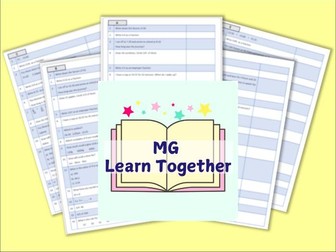KS2 Story writing 10 planning scaffolds with prompts. Lesson plan, tips, writing skills cheat sheet
<p>10 different structured story plans; full instructions on how to use; annotated diagram; suggested use for year 5&6 and 3&4; example week of planning using the resource; writing targets ‘cheat sheet’ with multiple examples for each objective.</p>
<p>Children find structuring their story to be the trickiest skill to master; these plans remove the barrier of structure to leave the children free to think up amazing vocabulary, use their growing sentence skills and enjoy being creative.</p>
<p>Included:</p>
<ul>
<li>
<p>The Activities - Each activity begins with a clear title and details about genre, voice and tense. Their plan features questions to answer, decisions to make and space to brainstorm interesting vocabulary. At the bottom of each plan is a challenge linked to curriculum writing expectations. There is also a blank template for the teacher to fill in their own prompts.</p>
</li>
<li>
<p>Cheat sheet - Easy to use list of writing skills with examples for each (fronted adverbial, sub-clause openers, onomatopoeia etc). These are bullet pointed and coloured to make the layout easy to skim and scan.</p>
</li>
<li>
<p>Instructions - annotated, labelled diagram with examples of what to write. Useful for the teacher or for parents if you want to use these as homework tasks.</p>
</li>
<li>
<p>Suggested use - Ways to use this for bother upper and lower key stage 2. Year 5 and 6 may use this as morning work throughout the week. Year 3 and 4 may use it as the basis of a story writing unit. There is an example week of planning for year 3/4 using this resource.</p>
</li>
</ul>
<p>All are fully editable powerpoint files also compatible with other programmes like open office or google slides.</p>
<p>Although the planning sheet provides a structure, the ideas are in no way limited and the choices are completely open to the children’s interests and imagination.</p>
<p>The aims of these activities are;<br />
*To inspire children to want to write<br />
*Foster enthusiasm and enjoyment of English<br />
*Give grown-ups a clear and focused way to help children achieve</p>








